Furntiure Retail Histories 1800-2011 Part 7
ARTE DE MEXICO
Destiny caught up with many of us in the ‘60s. The Kennedys and Camelot, Martin Luther King and “I have a dream”, the Vietnam War, the moon landing, the Beatles and “the British invasion” followed by the phenomenon of Woodstock. And the vibrations of this tumultuous decade were right on the mark for Arte de Mexico and its intensely entrepreneurial founder, Jerry Stoffers.
We have it on good authority that Jerry came into this ever-changing world a few years before in a small town in Iowa, “America’s Heartland”. He left home at 15, did his tour of duty in Vietnam on the other side of the planet, then settled in California. He loved the ocean, sun, sand and most especially surfing. It was surfing’s magic that led him to his next love affair, Mexico, its beautiful beaches and creative people.
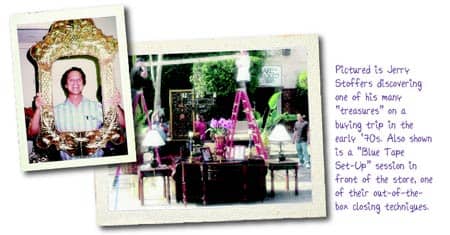
But reality struck! Jerry realized he needed a job. Fortunately his inherent imagination and passion for everything beautiful, permitted him to envision the enormous potential of Mexico’s history and art. And its enthusiastic acceptance by discerning North American consumers. With a rented U-Haul truck and $200 in his pocket, Jerry made tracks to Tijuana and Ensenada in search of treasure and a golden future. What he found as he explored studios and workshops was treasure indeed, the wealth of tradition and talent of Mexico’s artisans.
Back home in Los Angeles, Jerry continued to follow his instincts. He rented a parking lot on Hollywood Boulevard and, every Saturday and Sunday, unloaded his week’s cache to an appreciative and ever-growing audience of west coast decorators, designers, Hollywood celebrities and perceptive ordinary folk who zeroed in on his alfresco makeshift showroom.
There’s no doubt Jerry has an astute eye. From the beginning the items he brought across the border were unique and desirable. His collections represented centuries of culture, a real reflection of the history, ethnic mix and evolving perceptions of the Mexican scene. A pioneer, Jerry introduced the “maestro” to North America, those artists and craftspeople endowed with “hereditary traits”, passed from generation to generation. “Their vision encompassed qualities and techniques that should not be altered.” The maestros created intricate and detailed wrought iron, custom woodwork, silver objects and jewellery, exquisite pottery and hand carved and hand painted furniture and accessories.
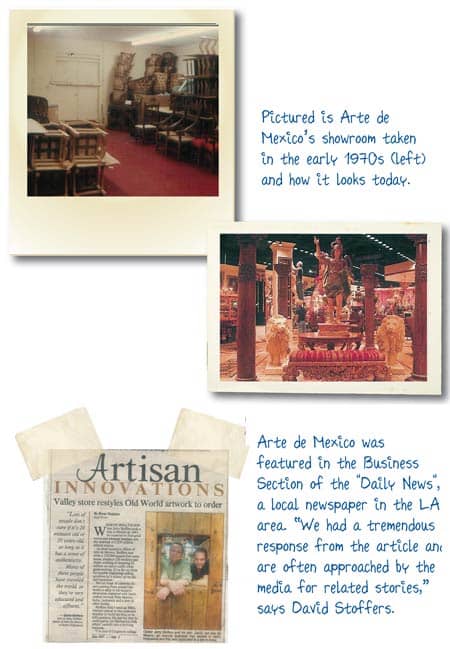
As time passed, demands for the work of the maestros increased, so Jerry and some of their leaders organized and financed cottage industries. Under Jerry’s direction, the designers fabricated their pieces to more functional contemporary standards while still maintaining their integrity and beauty.
David Stoffers, Jerry’s eldest son, said, “Jerry admits that when he was younger he sometimes tried to persuade the maestros to create things outside their natural talents. He soon realized that you have to work with people innately good at what they were born to do. He still seeks those honest ‘hereditary traits’ on his travels today.”
With his vision and hard work beginning to pay off, Jerry set his sights on other parts of the world. David continues the story, “His first journey took him to India, where Dad enthused, ‘I thought I’d died and gone to heaven seeing all those beautiful temples of the Maharajas!’ He discovered centuries old light fixtures, ancient carved wood doors, intricately carved fasciae and antique columns, all weathered by Mother Nature. He was like a kid in a candy store. He began immediately to negotiate the purchase of as many of these truly unique finds as possible, even visiting salvage yards. With a few years’ experience now under his belt, he began setting the stage for reproduction, keeping in mind still the importance of maintaining those very important hereditary talents.
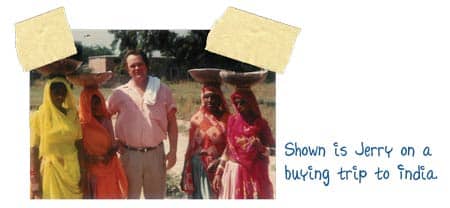
“Soon Jerry developed exclusive relationships with families and craftspeople in Morocco, Indonesia, Egypt, China, Italy, France, Spain, Argentina and Brazil. Making friends along the way with some of the most artistic and dedicated people in the world, Jerry had now become an international importer of custom furniture, amazing iron sculptures, carved wooden pieces, pottery, original painted artwork and silver objects of art, all unique, never before seen in the United States.
“For certain very special customers, Jerry made individual trips throughout Europe and Asia, looking for unusual one-of-a-kind pieces which, because of their antique state, had to be converted to more functional and contemporary standards. He brought them back to craftspeople with the talent to perform the required transformations.
“He has always been driven by his confidence, courage and fearless determination. He has created jobs for people in villages that had no other source of income; there are still cottage industries that he initiated in many parts of the world. He has come up with uncounted ideas and designs. He used these cottage industries and the extended families who supported them to work in a specific discipline or trade, and began adapting those all important hereditary skills or talents in carving wood, stone or the hand forging of wrought iron, turning them into designs that would work for consumers in our marketplace. We would take a pair of old doors and turn them into a headboard or maybe an armoire, thus adapting old world craftsmanship to our modern times.
“Jerry has been asked, ‘Don’t you feel bad, buying from such poor people?’ His response, ‘Are you kidding me? We are saving a culture and creating jobs. Hell, I’m Robin Hood!’ He was exactly that and he still is. He jumps on a plane and within an hour of landing he’ll be buying, In the streets of Morocco, on a camel, and two days later he’ll be on another plane to India, buying accessories.
“Above all, he is humble about his gifts. He is driven by long hard hours; it’s about the journey more than the destination. He knows there is a price to be paid to live a life filled with adventure, and the excitement of taking a bad situation and turning it into a profitable and exciting company is both the challenge and the reward.
“He has included me on quite a few of his travels that, in return, gave me experiences few boys ever have. As I travelled with him I truly saw the real world, and what it took to build a company to the present level of success. Few could do what he has done.”
Retail clients fly from all over the world to visit the Stoffers at their North Hollywood compound. The 150,000 square foot site that is still the cornerstone of Jerry’s now annual $50 million empire is supervised by David, and the Irvine showroom is managed by nephew, Jeff. Arte de Mexico is also present in High Point, North Carolina, a wholesale buyers’ showroom. After more than four decades, Arte de Mexico is renowned as a prominent retail supplier of eclectic furniture, architectural appointments and accessories. Clients include restaurants, hotels, movie and television studios, celebrities, noted architects, interior designers and affluent homeowners.
Said David, “When you enter our showrooms, they offer a visual extravaganza of old world craftsmanship, antiques, eclectic furnishings and rare artifacts that all work together in a masterfully harmonious mix. The international flair of the warehouse interior is further complemented by a continuous, contagious medley of music that adds to the exotic mood.
“Some of the unique services we offer currently include our ‘Blue Tape Set-Up’. A client will tell us the actual size of their room. We then template that size in our parking lot, we scale it with blue tape. We then place the furniture the client chooses within the defined area and the client can see precisely how it will look.
“Within our showrooms we don’t hesitate to turn off the lights in the entire area so a client can appreciate the ambience of a candlelit table. And we are happy to go to a client’s home with truckloads of furniture they’re considering and our guys will place the pieces in their space. No cost, of course. This has been very successful. The clients actually see the furniture/accessories in their home, resulting in a very high closing ratio!”
An interesting evolution: “As our retail business grew, we were sometimes asked to produce custom pieces based on existing pieces in our showrooms. For instance, taking a dining table and making it longer, or perhaps a buffet needed to be smaller and in a unique colour. There began the birth of our custom department! Clients tell us they appreciate the fact that we not only have a multi-million dollar inventory for them to select from, but we also can make anything to their liking.”
Arte de Mexico employs approximately 140 people in the United States, and supports the livelihood of more than 50 families representing now three generations of craftspeople from around the World.
“Today, something that was once a dream is now an enterprise. And Arte de Mexico’s tireless effort to fulfill our clients’ dreams will always be our foremost priority.”
The future, in Jerry’s own words, “My work is my hobby. I have yet to begin! I do it because I want to do it. I love to see pieces I have found turned into something others can enjoy. You have got to have passion for it. I have, and I always will!”
CONWAY FURNITURE
Forty-three years ago, the small town of Listowel, Ontario experienced a sea change occasioned by the arrival of two young and energetic entrepreneurs, Peter Dekker and Jim Mulholland. They were there to install carpets, and happened by chance to spot an empty store front downtown at the corner of Main and Wallace Streets. In a surge of optimism, they set up shop as Conway Furniture, retailing and installing carpets, then added home furnishings to fill up floor space. Conway was Jim’s mother’s maiden name, a good choice they decided, for its lack of ethnicity.
Within three years, they had opened two more stores, one in nearby Kincardine, the second in Hanover. But the following year, Peter bought Jim out. He’d conceptualized a major strategy change that involved closing the branch stores and erecting a brand new building on Conway’s present site, Highway 86, east of Listowel.
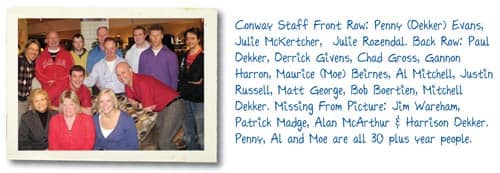
The town, according to Canada’s 2001 Census, has a population of 5,905, with “lots of subdivisions”. Back in January, 1857, John Binning, an earlier entrepreneur, bought wilderness land rights from a squatter named Henry for a “good rifle”, and kicked off the chain of events that shaped the now bustling Perth County community. Originally designated as Mapleton, the new name was chosen by a government official and refers to the town of Listowel in Ireland, most likely because the majority of the early settlers were of Protestant Irish origin or Ulster Scots. Ten years after Binning’s shrewd “trade”, Listowel was incorporated as a village and, eight years later, a town.
Peter’s new location gave him space to expand his product mix; he added appliances to his existing inventory of carpeting, flooring and furniture. He rented nearby warehouse space. Over the next 15 years, he built two other major additions, on-site warehousing and increased showroom area.
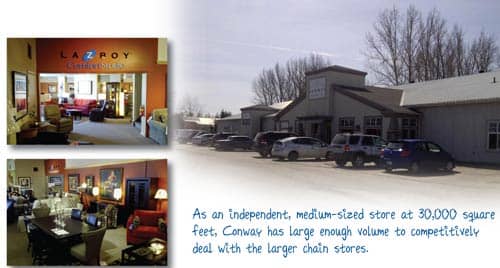
Paul, Peter’s teenage son, became part of the action as a part-time summer employee, and he continued to work part-time while completing his formal education. He studied physics at the University of Waterloo but, after three years, switched to business courses after he realized the potential of the solid family business his father had created.
In 1985, Paul’s first task was to open a Factory Clearance Centre. Eighteen months later when construction was completed on “The Gallery”, a new retail space focusing on vignette merchandising and decorating, the Centre closed. Peter made the decision to turn over Conway’s day-to-day operations to Paul in the late ‘90s.
“The Gallery” was converted to a La-Z-Boy Gallery in 1994 and is still in place as a “Comfort Studio” and is “going strong”. A few years earlier, electronics became part of Conway’s product mix, while appliances were dropped. But by 2004, Paul negated electronics to again refocus. “Our key strengths are in furniture, upholstery and flooring at mid-price point. Appliances and electronics are fields of their own. Let’s leave them to the Future Shops of the world!”
Conway’s vibrant character is a reflection of Paul’s personality and that of his sister, Penny Evans. She’s the force behind store and room design, and they’re a happy team. It just so happens that Paul has a fortunate knack for communications that serves Conway’s visibility in the area. “In our geographic area there are 20 different small newspapers, increasingly expensive with less return and certainly bad from the environmental point of view. Print, we decided, is not as successful for us as investing in effective radio. Flyers, too, are a tough nut, although we still do them. There is so much competition. Television is an occasional medium, generally in the spring and fall. But radio is another matter. We did a remote a few years ago at the store using an announcer from the station. Some of our customers said, ‘I heard your ad and I hated it!’ Of course I answered, ‘Well, you heard it at least!’ But this reaction did make me think and reconstruct.”
For more than a dozen years now, Paul has voiced his own radio commercials. “We’ve made them light and entertaining, a dialogue between me and the host of the morning show, ad libbing at the studio. We began with one station but now we run with seven stations in the region. It works really well in a rural area like this. We can get our messages across.” And isn’t it lucky that Paul has a really excellent radio voice!
Here’s a quote from one of Paul’s Listowel customers: “On a rotten, cold morning driving to work, snow flying, horrible slippery conditions and a thousand things on your mind, Paul actually makes me smile!”
Conway also communicates through area projects. “This year we made major donations to our local hospital, to an arena renovation project in a neighbouring town, gave a $5,000 furniture voucher for our Kinsmen Club to raffle, and another $1,000 to our local Agricultural Society.” He’s played keyboard and was soundman for a church cantata and, with his band, he’s involved in Listowel’s popular Irish “Paddyfest” held annually over the two weeks surrounding St. Patrick’s Day, sponsored by the Kinsmen and Kinettes of the town. “Two local volunteer firefighters, one of them a Kinsman, were killed this year in the middle of Paddyfest. We had 15,000 service men and women in town for a memorial service. It’s always tough to lose good people.”
Paul has been in the midst of renovations again, “an ongoing part of staying in front of the pack”. Offices and accessible washrooms were involved, “and a shower for staff who choose to bike to work. Part of the renovation provided us with a large white wall in the warehouse so we can photograph items as they go to the showroom for use on our website and Facebook. We will tweet the new arrivals as they hit the floor”.
Paul’s two sons, Mitchell, aged 20, and Harrison, two years younger, have just joined Conway’s staff. “Mitchell has completed his college and is working in the warehouse and on deliveries, starting at the bottom as we all should.
Harrison is working part time after high school. I’m not sure if the future of Conway lies in them, but this is a good way to find out! My nephew Patrick (my sister Penny’s youngest), after being a ski bum for a winter at Revelstoke, is also returning for the summer before going into a business programme. And I’m really excited about the team we have assembled at Conway. There’s some fresh blood in the office and on the sales floor with positive attitudes and an ability to learn.
“We have moved our product mix a little bit more contemporary, but have stayed the course with mostly North American made furniture. We recently set up a Simmons Bed Gallery placing us ahead of our local bedding competition and allowing us to go head to head against Sleep Country about a half hour away.
“Environmentally we’ve made progress. I converted 90 per cent of my lighting to LED over the last two years and shaved $8,000 off my utilities, about 25 percent while prices increased. Even with adding more fixtures to compensate for some reduction in brightness. We’ve experienced substantial savings in air conditioning due to the reduction in heat produced by lighting.”
As an independent, medium-sized store at 30,000 square feet, Conway has “large enough volume to competitively deal with the larger chain stores, our reach from the city of Kitchener towards Lake Huron and from Mount Forest towards Mitchell, then up as far as Goderich and Port Elgin. Our strength is the Highway 8 and Highway 9 corridor, the shoreline of Lake Huron. Our demographic targeting is more to the second time or more mature buyers, the average income consumer from 35 to seniors. Conway is a fashion store. Our slogan is ‘Today’s home trends embraced under one roof”.
We asked Paul’s opinion about the decade to come. “I think the greed and gluttony of the last 20 years needs to slow up. The quest for efficiency and price without thought for the workers or the environment has to stop.
Cheaper and cheaper has led consumers to think they are entitled to every new item, and that retail businesses offer nothing but unwanted markup. We need to slow down and regain our lives. (Well, not me personally as I got 26 ski days in the west this year!) Thank goodness the cost of importing is rising and as such I think we will see less import product, better domestic products with durability. As always, the strong will survive and the weak will move on.”
MATTRESS GIANT
It took the force of Hurricane Andrew to propel Mattress Giant all the way from the Florida Coast to the Town of Addison, a northern suburb of Dallas, Texas. Addison’s Airport is the third largest in the nation and home base for Martinaire Aviation. Nearby thrive many large corporations including Mary Kay Cosmetics, Dresser, Compuware, HP Enterprise Services and Jani-King. At night, when the corporate lights dim, Addison reverts to its core population of 14,166. During the day it’s over 100,000.
In 1982, a decade before, Sam Katz, one of the three founders of Mattress Discounters of Washington, D. C., and Rich Nilsen, a Mattress Discounter employee, after much discussion made the decision to move from Washington to Florida to open a small mattress business. They were looking for a quieter, easier life. And better weather!
Originally, the partners called the business Mattress City but later their natural optimism (and huge selection of product lines) called for a real designation change and the enterprise became Mattress Giant. Then came the hurricane, and Addison strongly beckoned as a great place for expansion.
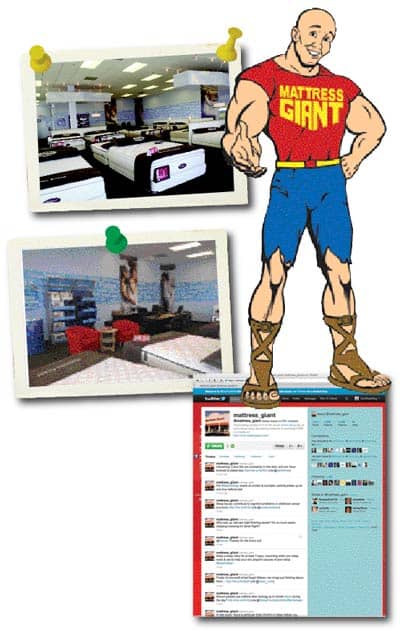
Abe Long and his brother, Phil, still back in Washington and employed by Mattress Discounters, joined Sam and Rich to partner in the burgeoning business. The pace quickened and in 1992 Mattress Giant opened in Dallas. The following year, another expansion, this to Houston. Two years later, the Florida and Texas Giants merged and growth accelerated into markets across the United States.
A Giant celebration in 2008 marked their 25th year in business with internal festivities and special offers and contests for the corporation’s customers. It was an excellent year that also produced strategic acquisitions and included yet another expansion into the Atlanta market.
Today, Sam and Rich’s “quieter, easier life” has evolved into an empire of 328 locations in 14 states. And there are now 794 employees (sleep advisors!) under the Giant’s umbrella! And offerings of more than 40 varieties of mattresses in each store. Key to their marketing philosophy, their customer service training program is “designed to make the mattress buying experience one of ease, putting each customer’s individual sleep needs first and designing the experience around them”.
We asked The Giant about their eureka moment, a meaningful step forward, a plan that provided a competitive edge. “Mattress Giant was at the forefront of social media and was one of the first mattress retailers to connect with consumers utilizing social media. This has enabled customers to have an additional avenue to get their questions answered, learn about the products we sell, win prizes (thanks to our great manufacturer partners) and let us be a solution in their lives through providing tips to achieve a better night’s sleep. We’re proud of our award winning BetterSleep program, now in its third year of providing value to our consumers’ lives through social media.”
But Mattress Giants’ marketing outreach not only provides helpful tips on good sleeping practices, it also offers off-the-wall videos designed to entice consumers into their stores laughing all the way! They invite you to visit their very friendly website, www.mattressgiant.com to view the useful information about locations, warranties, collections, job opportunities, etc., but also to spend some time marveling at Giant’s many highly entertaining videos. And you can find them too at twitter.com/ mattress_giant and on Facebook, facebook.com/mattressgiant.
We also asked if there had been a really special time in Mattress Giant’s history. And there was, just last year.
“When we began traffic counting and conversions, we were able to uncover, track and benchmark key information that helped our business excel in areas like operations, real estate, training and marketing. We get reports each week, obviously very helpful indeed! There has been a direct correlation with social media engagement and increased sales.” Moving with the times.
Next Issue
Next month we will continue this series that commemorates the 140th anniversary year of FURNITURE WORLD Magazine. These are your stories, the tales you told us, the dreams that became realities.